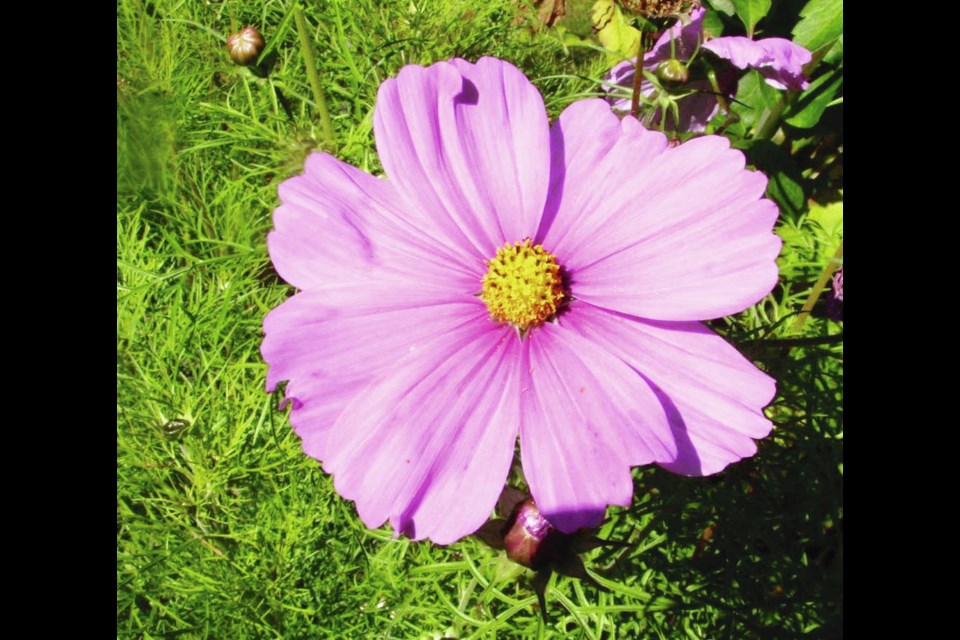I hadn’t ridden my bike for some time, following a knee injury, but a few weeks ago I sensed the ancient Raleigh calling to me. I had it checked out at a local cycle shop and off I went, wobbles on display, along my old favourite route — up a gentle hill, along a level patch, and up two steeper hills, which I just managed, before circling a substantial, manicured subdivision and returning home.
On my second ride over the same route, I remembered to check out a corner property where I used to enjoy the sight of old-fashioned cosmos blooming out of rock chips at the rounded corner of the lot.
The cosmos was there, still flowering in early October and suggesting the possibility of seeding easy annual flowers that self-sow generously enough to bless an undisturbed plot of ground with yearly displays of colourful bloom.
Cosmos is a staple in traditional “cottage” flower gardens. Among all the newer, fancier varieties now available, Sensation, a tall, free-flowering plant with a bushy shape, ferny leaves and large, single flowers has been popular ever since its introduction as an award-winning variety in 1936. Sensation grows 120 cm tall. For small spaces, Dwarf Sensation (T&T Seeds) grows to just 60 cm. It has done well in my garden.
Other annual flowers that self-sow freely in my garden are calendula (pot marigold), larkspur, peony-flowered poppies (Papaver somniferum), borage and Nicandra (shoo-fly plant).
Memories. It was a Thanksgiving weekend email from a reader that turned my thoughts to cosmos and the self-perpetuating patch of the plants growing out of rock chips on my bike route.
Susan wrote to express her gratitude for a long life filled with the “love of and wonder at gardening,” which she attributes to two men: her grandfather, who taught her how to sow seeds, tend plants, wait, and marvel at the appearance of flowers, and my father, whose offer of free seeds through his gardening column introduced Susan to cosmos when she was a small child.
That little packet of seeds, and the flowers they produced thanks to the guidance of her grandfather, turned out to be the starting point of Susan’s lifelong enjoyment in and appreciation of gardens, flowers, and working in the soil.
Sexy onions. I hadn’t ever viewed the flats of onion bulbs I harvest each year as particularly erotic, but social media sensors thought so, deeming a photo of onions in a basket (an ad for onion seed) to be “overtly sexual.”
Earthy, yes, and the delicious bedrock of many a meal. Who is not sensually stimulated by the scent of onions sizzling on a stove? But sexy?
Still, I can see how those plump, fleshy orbs could be seen as having a certain voluptuous allure. They certainly feature as highlights in many of the meals I prepare.
I’m thinking of chunks of sweet, juicy white onion combined with freshly picked, sun-warmed tomato, cucumber from the garden, sweet yellow or orange bell pepper, feta cheese and kalamata olives in a Greek salad — a zesty, satisfying, colourful summer meal.
Crispy-fried onions are a favourite topping for a green salad.
Whenever I bake a chicken breast, thighs or wings I add to the poultry pieces in the pan halved or quartered onion bulbs and peeled garlic cloves along with garden herbs — sage leaves, rosemary, or thyme. Drizzled over everything is melted butter to which freshly squeezed lemon juice has been added. The last touch before baking is a dusting of grated salt.
A special treat is a (purchased) rectangle of puff pastry topped with two large, thinly sliced onions cooked golden brown with a little minced rosemary. The cooked onions are mixed with a blend of one egg and a quarter cup milk before spreading them on the pastry, keeping some of the liquid in reserve for brushing the pastry edges after they are folded.
Over the onions I arrange pre-soaked, dried fig halves that I have frozen, crumbled feta cheese, pieces of sweet red pepper, and pine nuts. Once the toppings, which can vary, are in place the pastry edges are folded inward to form a slight rim and brushed with the egg and milk mixture. Bake at 375 F for around a half hour or until the pastry is golden.



